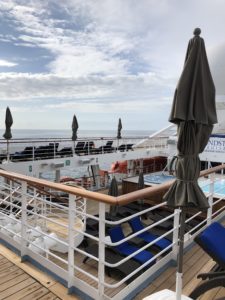 Sometimes life does not go as planned.
Sometimes life does not go as planned.
Today we were to anchor in Portrush in Northern Ireland.
The Wife and I planned to see the Giants Causeway and visit Royal Portrush Golf Club shop. It was not to be.
The swells were too large, and our captain determined it unsafe to attempt to tender to shore.
So, we pressed on to our next stop, the Isle of Man.
Another day at sea is not a bad thing. It’s a day to read and relax, and that is what I did. I was able to finish the book, St. Patrick of Ireland, by Philip Freeman.
Patrick was born in Britain in the late 4th century into a well-to-do family. Patrick was a Roman citizen. His family were Roman Christians, but Patrick rejected his family’s Christianity as an adolescent. Then, when he was approximately 15 years old, Irish slave traders snuck into his village one night, kidnapped him and others, and took them away to Ireland to be sold into slavery.
Patrick was then a slave in Ireland, shepherding sheep for his master, during which time he earnestly sought the Lord. After six years, the Lord spoke to Patrick telling him his ship was waiting for him. Patrick left (at the risk of his life) and walked 200 miles to the Irish coast where he was able to catch a ship that took him away from Ireland and ultimately back to his family in Britain.
Patrick entered the ministry and asked his superiors to allow him to return to Ireland to preach the Gospel to the Irish. Although his superiors were skeptical they reluctantly agreed. Over the remainder of his life, Patrick travelled throughout Ireland spreading the Gospel. If there was ever a situation where one could attribute the evangelizing of an entire nation to a single person it would be Ireland and Patrick.
On reading the story of St. Patrick, I was immediately struck by the similarity to the experience of John Knox, who was taken away into the slavery of a French Galley but vowed to return, and did return, to preach at St. Andrews and lead the Scottish Reformation. Or how about Martin Luther’s self-imposed exile to Wartburg Castle? Or Moses’s escape and exile in Midian? Or Joseph’s slavery in Egypt. In each instance, in hindsight, one can see the sovereignty of God. In the instant, we can only often guess and continue to follow Jesus.
So, how do we know the story of St. Patrick is true? Well, we know because we have Patrick’s short autobiography, Confessions, as well as another letter he wrote. There are seven copies extant, one of which is at Trinity College in Dublin, which we hope to visit Saturday. GS

